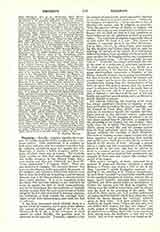

Virginity. —Morally, virginity signifies the reverence for bodily integrity which is suggested by a virtuous motive. Thus understood, it is common to both sexes, and may exist in a woman even after bodily violation committed upon her against her will. Physically, it implies a bodily integrity, visible evidence of which exists only in women. The Catholic Faith teaches us that God miraculously preserved this bodily integrity in the Blessed Virgin Mary, even during and after her childbirth (see Paul IV, “Cum quorundam”, August 7, 1555). There are two elements in virginity: the material element, that is to say, the absence, in the past and in the present, of all complete and voluntary delectation, whether from lust or from the lawful use of marriage; and the formal element, that is the firm resolution to abstain forever from sexual pleasure. It is to be remarked, on the one hand, that material virginity is not destroyed by every sin against the sixth or, ninth commandment, and on the other hand that the resolution of virginity extends to more than the mere preservation of bodily integrity, for if it were restricted to material virginity, the resolution, at least outside the marriage state, might coexist with vicious desires, and could not then be virtuous.
It has been sometimes asked whether there is a special virtue of virginity; and in spite of the affirmative answer of some authors, and of the text of St. Thomas, II-II, Q. chi, a. 3, the statement of which cannot be taken literally, the question must be answered in the negative. Formally, virginity is butthe purpose of perpetually preserving perfect chastity in one who abstains from sexual pleasure. Ordinarily this purpose is inspired by a virtue superior to that of chastity; the motive may be religious or apostolic. Then the superior virtues of charity or religion will ennoble this purpose and communicate to it their own beauty; but we shall not find in it any splendor or merit which are not the splendor or merit of another virtue. The resolution of virginity is generally offered to God under the form of a vow. The counsel of virginity is expressly given in the New Testament; first in Matt., xix, 11, 12, where Christ, after reminding His disciples that besides those who are unfit for marriage by nature, or by reason of a mutilation inflicted by others, there are others who have made the same sacrifice for the kingdom of heaven, recommends them to imitate these. “He that can take, let him take it.” Tradition has always understood this text in the sense of a profession of perpetual continence. St. Paul again, speaking (I Cor., vii, 25-40) as a faithful preacher of the doctrine of the Lord (tamquam misericordiam consecutus a Domino, ut sim fidelis), formally declares that marriage is permissible, but that it would be better to follow his counsel and remain single; and he gives the reasons; besides the considerations arising from the circumstances of his time, he gives this general reason, that the married man “is solicitous for the things of the world, how he may please his wife: and he is divided”; whereas he that is without a wife directs all his care to his own bodily and spiritual sanctification, and is at liberty to devote himself to prayer.
The Church, following this teaching of St. Paul, has always considered the state of virginity or celibacy preferable in itself to the state of marriage, and the Council of Trent (Sess. XXIV, can. 10) pronounces an anathema against the opposite doctrine. Some heretics of the sixteenth century understood Christ’s words, “for the kingdom of heaven”, in the text above quoted from St. Matthew, as applying to the preaching of the Gospel; but the context, especially verse 14, in which “the kingdom of heaven” clearly means eternal life, and the passage quoted from St. Paul sufficiently refute that interpretation. Reason confirms the teaching of Holy Scripture. The state of virginity means a signal victory over the lower appetites, and an emancipation from worldly and earthly cares, which gives a man liberty to devote himself to the service of God. Although a person who is a virgin may fail to correspond to the sublime graces of his or her state, and may be inferior in merit to a married person, yet experience bears witness to the marvellous spiritual fruit produced by the example of those men and women who emulate the purity of the angels.
This perfect integrity of body, enhanced by a purpose of perpetual chastity, produces a special likeness to Christ, and creates a title to one of the three “aureolae””, which theologians mention. According the teaching of St. Thomas (Supplement Q. xcvi) these “aureolae” are particular rewards added to the essential happiness of eternity, and are like so many laurel wreaths, crowning three conspicuous victories, and three special points of resemblance to Christ: the victory over the flesh in virginity, the victory over the world in martyrdom, and the victory over the devil in the preaching of the truth. The text of St. John (Apoc., xiv, 1-5) is often understood of virgins, and the canticle which they alone may sing before the throne denotes the “aureola” which is given to them alone. It is most probable that the words in the fourth verse, “These are they who were not defiled with women: for they are virgins”, are really spoken of virgins, though there are also other interpretations; perhaps those who “were purchased from among men, the first fruits to God and to the Lamb: And in their mouth there was found no lie” (loc. cit., 4, 5) are the martyrs; they are declared to be without spot, as in an earlier chapter (vii, 14); they are said to “have washed their robes, and have made them white in the blood of the Lamb“.
In the article Nuns it is shown how Christian virgins have been one of the glories of the Church since the first ages, and how very ancient is the profession of virginity. Under Religious Life is treated the difficulty of proving the strict obligation of perseverance before the fifth century, when we meet with the letter of Innocent V (404) to Vitricius (chapters xiii, xiv; cf. P.L., XX, 478 sqq.). Even at an earlier period still, the bishop presided at the clothing, and the consecration of virgins became a sacramental rite, in which the prayers and benedictions of the Church were added to the prayers and merits of those who presented themselves, in order to obtain for them the grace of fidelity in their sublime profession. In the fourth century no age was fixed for the consecration; virgins offered themselves when quite young, at ten or twelve years of age. As there were children offered by their parents to the monastic life, so also there were children vowed to virginity before their birth, or very shortly after. Subsequently the law was passed which forbade consecration before the age of twenty-five years.
The ceremony prescribed in the Roman Pontifical is very solemn, and follows, step by step, that of an ordination. It is reserved to the bishop, and can never be repeated. The days fixed for the solemnity were at first the Epiphany, Easter week, and the feasts of the Apostles. The third Council of the Lateran gave permission to consecrate virgins on all Sundays, and custom sometimes extended the permission (C. Subdiaconos, 1, De temp. ordinat., 1, 10). The ceremony takes place during Mass; the archpriest certifies the worthiness of the candidates, as he does that of the deacons. After the introductory hymns, the pontiff first asks them all together if they are resolved to persevere in their purpose of holy virginity; they answer: “Volumus” (we are). Then he asks each one severally: “Dost thou promise to preserve perpetual virginity”? and when she answers, “I do promise”, the pontiff says, “Deo gratias”. The litany of the saints is then sung, with a double invocation on behalf of the virgins present: “Ut praesentes ancillas benedicere sanctificare digneris” (“That thou wouldst vouchsafe to bless and sanctify thy handmaidens here present”). It is to be remarked that the third invocation, “et consecrare digneris” (“That Thou wouldst vouchsafe to consecrate them”), which is added for major orders, is omitted here. The hymn “Veni Creator” follows, after which the pontiff blesses the habits, which the virgins put on. He then blesses the veil, the ring, and the crown. After the singing of a very beautiful preface, the bishop gives these three articles to the virgins with the formulae used in ordinations, and the ceremony ends with a benediction, some prayers, and a long anathema directed against any persons who attempt to seduce the virgins from their holy profession. Sometimes after the Mass, the bishop gave them, as also to the deaconesses, the Book of Hours, to recite the Office.
From the fourth century the virgins wore a modest dress of dark color; they were required to devote themselves to prayer (the. canonical hours), manual labor, and an ascetic life. After the eighth century, as enclosure became the general law for persons consecrated to God, the reason for this special consecration of persons, already protected by the walls of the monastery and by their religious profession, ceased to exist. Secret faults committed before or even after admission to the monastery led to questions which were very delicate to decide, and which became the subject of controversy. Was one who had lost her virginity to make the fact known at the price of her reputation? Was it enough to present herself as a virgin in order to be able to receive consecration? (See for example “Theol. moralis Salmaticensium”, Q. xvi de 6 et 9 praecepto, i, n. 75; or Lessius, “De justitia”, etc., IV, ii, dub. 16.) The ceremony became more and more rare, though examples were found still in the thirteenth and fourteenth centuries; but it was not practiced in the Mendicant orders. Saint Antoninus knew it in the fifteenth century; while St. Charles Borromeo in vain tried to revive it in the sixteenth. The abbess alone received and still receives a solemn benediction.
Virginity is irreparably lost by sexual pleasure, voluntarily and completely experienced. “I tell you without hesitation”, writes St. Jerome in his twenty-second Epistle to St. Eustochium, n. 5 (P.L., XXII, 397) “that though God is almighty, He cannot restore a virginity that has been lost”. A failure in the resolution, or even incomplete faults, leave room for efficacious repentance, which restores virtue and the right to the aureola. Formerly virginity was required as a condition for entrance into some monasteries; at the present day, in most congregations, a pontifical dispensation is necessary for the reception of persons who have been married (the Order of the Visitation however is formally open to widows); but bodily integrity is no longer required. If the candidate’s reputation is intact, the doors of monasteries are open to a generous repentance as to a generous innocence. (See Nuns; Religious Life; Vows; Religious Veil.)
A. VERMEERSCH


